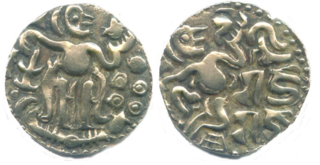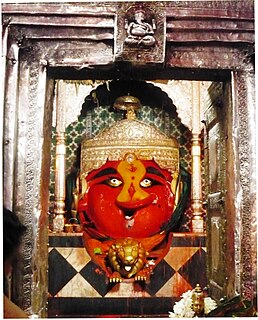
The Kasba Ganapati refers to both a particular murti of the god Ganapati in Pune, India, as well as to the temple built around the murti. The Kasba Ganapati is the presiding deity (gramadevata) of Pune.

Rajadhiraja I was a Chola emperor and the successor of his father, Rajendra I. During his short reign, he helped his father conquer several territories and maintained the Chola authority over most of Sri Lanka, Eastern Chalukya, Kalinga, among others and also the relations with overseas domains despite a series of revolts in the territory. Rajadhiraja Chola proved capable of maintaining the vast and expansive empire with territories even outside the shores of India. Records also show that the king was a skilled commander on the battlefield, leading his soldiers from the front lines. He earned the title Jayamkonda Chola after numerous victories. Towards the end of his reign, he sacked the Western Chalukyan capital Kalyanapuram and assumed the title Kalyanapuramgonda Chola and performed a Virabhisheka under the name Vijaya Rajendra Cholan.

Mahur or Mahurgad is a town and religious place in Nanded district of Maharashtra, India. Mahur is the birthplace of Hindu God Dattatreya. Dattatreya parents Atri Rishi and Sati Anasuya Mata lived here. Brahmadev, Vishnudev and Lord Shiva once got a news about Anusaya Mata that there is no one more pious and pure as her. To test her piousness they arrived under the garb of asking Alm (bhiksha). Near Mahur, There is a Pious confluence of River Penganga and River Pus at Hiwara Sangam village, Tal. Mahagaon Vidarbha, from where the river flows northward. Penganga river forms a border between Vidarbha and Marathwada. Mahur falls just about 3kms inside Marathwada due to river banks.

Rajendra Chola II reigned as the Chola emperor succeeding his elder brother Rajadhiraja Chola I in the 11th century after his brother dead. He is best remembered for his role in the Battle of Koppam along with his elder brother Rajadhiraja Chola where he dramatically turned the tables on the Chalukyan King Someshvara I, after the death of his brother in 1052. During his early reign an expedition was led to Sri Lanka, in the course of which the Sri Lanka army was routed and their king Vijayabahu I of Polonnaruwa was driven to take refuge in a mountain-fortress. He maintained the Chola Empire well as the distribution of his records show that the Chola Empire did not suffer any loss of territory during his reign by protecting the territory.

Daksharama is one of the five Pancharama Kshetras that are sacred to the Hindu god Siva. The temple is located in Daksharamam town of East Godavari in the Indian state of Andhra Pradesh. Bhimeswara Swamy refers to Lord Siva in this temple.

Ksheerarama is one of the five Pancharama Kshetras that are sacred to the Hindu god Shiva. The temple is located in Palakollu of West Godavari in the Indian state of Andhra Pradesh. Shiva is known locally as Ksheera Ramalingeswara Swamy. The Sivalinga was established by Vishnu. It is believed that staying one day in Kshirarama is equivalent to staying one year in Varanasi. It is one of the centrally protected monuments of national importance.

Kumararama or Bhimarama is one of the five Pancharama Kshetras that are sacred to the Hindu god Shiva. The temple is located in Samalkota of East Godavari district in the Indian state of Andhra Pradesh. The other four temples are Amararama at Amaravati(Dist. Guntur), Draksharama at Draksharama, Ksheerarama at Palakollu and Somarama at Bhimavaram(both in Dist. West Godavari). It is one of the centrally protected monuments of national importance.

North Karnataka, is a geographical region in Deccan plateau from 300 to 730 metres elevation that constitutes the region of the Karnataka state in India and the region consists of 13 districts. It is drained by the Krishna River and its tributaries the Bhima, Ghataprabha, Malaprabha, and Tungabhadra. North Karnataka lies within the Deccan thorn scrub forests ecoregion, which extends north into eastern Maharashtra. Most parts of the region has black fertile soil ideal for agriculture.

Gajendragad is a town and a sub-district place in Gadag District, Karnataka, India. This place is known for its hill station and hill strip. Highest populated city after Gadag in the district. It is about 55 kilometers from the district head quarter Gadag, 110 kilometers from Hubballi, 200 kilometers from Belagavi and 450 kilometers from state capital Bengaluru.
Indapur is a town and a municipal council in Pune district in the Indian state of Maharashtra. Indapur is known for Jahagir of Shivaji's father and grandfather. Shivaji's grandfather Malojiraje died in battle in Indapur.
Santaji Mahaloji Ghorpade,(1645–1696) popularly known as ‘Santajirao’ or ‘Santaji Ghorpade’, was most celebrated warrior and sixth Sarsenapati of the Maratha Empire during Rajaram's regime. His name became inseparable from the name of Dhanaji Jadhav with whom he made campaigns against Mughal Army continuously from 1689 to 1696. He is considered to be one of the most foremost exponents of ganimi kava.
Atpadi is an administrative town of the Atpadi Taluka of Sangli District in the Indian state of Maharashtra. Atpadi is located north-east of Sangli District and shares borders with the adjacent Solapur and Satara Districts. The town has a taluka administrative office, a courthouse, a police station, a government-run primary hospital, various schools and colleges and a theater. Atpadi's economy is based on the cultivation and sale of agricultural products, with pomegranates and cotton constituting the core of the industry. The town is also home to the Manganga Sahakari Sugar factory, a Pomegranate auction center and various small scale industries in fields such as manufacturing, processing, servicing and repairs.
The Dashabhuja Temple is a Hindu temple in Pune, in the Maharashtra state of India. This temple was once owned by Sardar Haripant Phadke, a Sardar of Peshwa and was later donated to the Peshwas as dowry. Dashabhuja Ganapati temple is visited by thousands of devotees every day and the number increases during Ganesh Chaturthi.The idol of Ganpati or Ganesh seen here has his elephant trunk resting on his right-hand side, which is supposed to be rarer and more sacred than other forms of the Ganesh idol.

The Eastern Ganga dynasty also known as Rudhi Gangas or Prachya Gangas were a large medieval era Indian royal dynasty that reigned from Kalinga from as early as the 5th century to the early 15th century. They are known as "Eastern Gangas" to distinguish them from the Western Gangas who ruled over Karnataka. The territory ruled by the dynasty consisted of the whole of the modern-day Indian state of Odisha as well as major parts of West Bengal, Andhra Pradesh and Chhattisgarh. The early rulers of the dynasty ruled from Dantapuram; the capital was later moved to Kalinganagara, and ultimately to Kataka . Today, they are most remembered as the builders of the world renowned Puri Jagannath Temple and Konark Sun Temple, a UNESCO World Heritage Site at Konark, Odisha.

Jainism in North Karnataka flourished under the Chalukyas, Kadamba, Rashtrakutas, and Vijayanagara empire. Imbued with religious feeling, patronage was extended towards the building of Jain temple and it garnered high repute among the people, particularly the ruling classes and the mercantile community; effectively getting treated as the state religion.
Shri Kuruvathi Basaveshwara temple at Kuruvathi is one of the ancient and historic temples at the extreme south-western corner of Hoovina Hadagali taluk, Vijayanagara District, Karnataka, India. This temple is on the bank of Tungabhadra river, 10 km from Halavagalu and 2 km from Mylara and 36 km from Ranebennur and 326 km from Bangalore.

The Chalukya dynasty was a Classical Indian dynasty that ruled large parts of southern and central India between the 6th and the 12th centuries. During this period, they ruled as three related yet individual dynasties. The earliest dynasty, known as the "Badami Chalukyas", ruled from Vatapi from the middle of the 6th century. The Badami Chalukyas began to assert their independence at the decline of the Kadamba kingdom of Banavasi and rapidly rose to prominence during the reign of Pulakeshin II. After the death of Pulakeshin II, the Eastern Chalukyas became an independent kingdom in the eastern Deccan. They ruled from Vengi until about the 11th century. In the western Deccan, the rise of the Rashtrakutas in the middle of the 8th century eclipsed the Chalukyas of Badami before being revived by their descendants, the Western Chalukyas, in the late 10th century. These Western Chalukyas ruled from Kalyani until the end of the 12th century.

Siddhanath Temple, located in Mhaswad, is dedicated to the veneration of Lord Siddhanath. Siddhanath is believed to be incarnation of Shiva and the patron god of adjacent regions and one of among several regional protective (Kshetrapal) gods of Maharashtra. Mhaswad is situated in the bank of Manganaga river.

The Culture of Telangana in India has a cultural history of about 5,000 years. The region emerged as the foremost centre of culture in Indian subcontinent during the rule of Kakatiyas, the Qutb Shahis and Asaf Jahi dynasties—. The rulers patronage and interest for culinery, arts and culture transformed Telangana into a multi-cultural region where two different cultures coexist together, thus making Telangana the representative of the Deccan Plateau and its heritage with Warangal and Hyderabad being its epicenter. Hyderabadi cuisine and Kakatiya architecture both from Telangana, are on the list of UNESC0Bold text creative city of gastronomy and UNESCO World Heritage Site. The regions major cultural events celebrated are "Kakatiya Festival" and Deccan Festival along with religious festivals Bonalu, Bathukamma, Dasara, Ugadi, Sankranthi, Milad un Nabi and Ramadan.

Avanangattilkalari Sree Vishnumaya Temple is a Hindu temple at Peringottukara, Thrissur District, Kerala state, India. It is dedicated to the god Vishnumaya in Kerala. The god is known also by the names Chathan.














